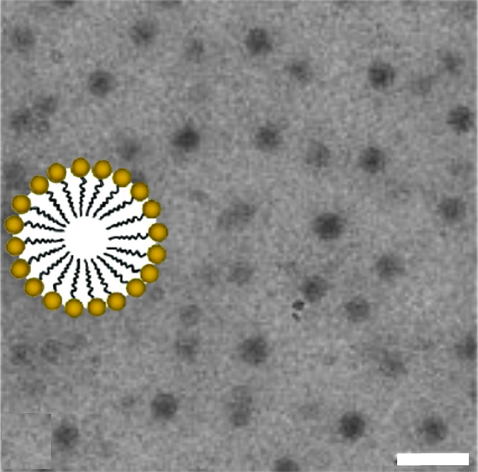Are you a journalist? Please sign up here for our press releases
Subscribe to our monthly newsletter:
The answers to life’s greatest questions – the when, what and how of its origins – have yet to be fully resolved. Currently, the leading hypothesis within the scientific community is that life developed from RNA molecules, known for their self-replication ability. Yet for the past two decades, Prof. Doron Lancet, of the Weizmann Institute of Science’s Molecular Genetics Department, has been swimming against the currents of the primordial soup. “It is highly improbable that the origin of life traces back to a single complex molecule such as RNA,” says Lancet, “but more likely to assemblies of simple chemical compounds that can form spontaneously and reproduce as a whole.”
To demonstrate the feasibility of this alternative timeline, Lancet has developed a computational chemistry model that has so far been considered to be a theory in search of experimental support. In their recently published papers, Lancet and research students Amit Kahana and Svetlana Maslov present, for the first time, a convincing compendium of experimental data that substantiates their origin of life model.

NASA defines life as a “chemical system capable of reproducing itself and undergoing Darwinian evolution.” Thus, the answer to the question of life’s inception could lie in the search for the simplest chemical entity that meets these conditions. One of the major caveats in the assumption that RNA was the first such entity to materialize in the primordial soup – the chaotic environment from whence life emerged – is that it is a highly complex molecule that, probabilistically, could not have just spontaneously emerged. RNA molecules that are able to replicate consist of tens, and often hundreds, of discrete molecular units organized linearly. These units, in turn, are assumed to be distilled from a milieu containing millions of other different molecules, a next to impossible feat. Should the smallest error befall this intricate puzzle, the RNA molecule simply won’t replicate. While the staunch supporters of the RNA hypothesis admit to the model’s shortcomings, they have not yet been able to come up with a favorable alternative.
So, if not RNA, what could be considered to be life’s bedrock, the first reproducing and evolving chemical system? Opponents of the RNA paradigm have long argued that the answer to this question cannot be resolved at the level of a single molecule. “Within cells,” says Lancet, “no single molecule can duplicate on its own; it is the entire cellular ensemble that reproduces.” Inside the cell, a catalyzed network of chemical reactions is at work, responsible for absorbing and producing additional copies of all of the cell’s components. During the cell cycle, this ensemble grows and later splits, with the offspring similar to the “mother,” as well as to each other.
Micelles can create copies of their molecular composition as they develop – and later on split – which is reminiscent of how cells behave
The molecular ensembles proposed by Lancet as the earliest reproducible entities are called micelles – nano-scale spheres the size of viruses, composed of lipid molecules. These possess a unique property: They are made up of a water-“loving” head, and a water-“hating” tail. This arrangement enables lipids to perform their task as the principal structural component of the membranes that surround every living cell, as well as to form into significantly smaller micellar structures.
Micelles also constitute an important part of our everyday lives. Dishwashing soap, for example, is made up of lipid-like detergents. When soap contacts water, micelles typically form that are able to trap greasy particles inside where the water-“hating” tails organize. Soap aside, it has been demonstrated that lipid molecules could have formed on ancient Earth and may even have arrived here carried on meteorites. Previous studies by Lancet have further provided evidence that micellar structures, unlike RNA, could have readily formed spontaneously in the chaotic primordial environment.
For lipid micelles to be considered candidates for the origin of life, they must show catalytic properties, namely, a capacity for speeding up reaction processes. In their first paper, the researchers present comprehensive evidence for just that: diverse instances of lipid catalysis. These findings, derived unexpectedly from the chemical industry, support the notion that micelles can indeed mimic present-day cells. The researchers also surveyed studies that implemented Lancet’s computational model to predict the behavior of lipids under a variety of conditions. These studies demonstrate that micelles can create copies of their molecular composition as they develop – and later on split – which is reminiscent of how cells behave.

And what about evolution? Given that micellar replication is error prone – similar in a way to how DNA acquires spontaneous, random mutations – it could drive forward evolutionary processes. The researchers address this aspect as well by introducing new routes by which micelles could have evolved to gradually become more complex, toward becoming what are known as protocells – simple precursors of modern cells. In the second paper, the scientists provide further biochemical evidence that chemical groups, attached to the water-“loving” surface of micelles, may form molecular recognition sites, comparable to those found in present-day proteins.
Although the micellar model for the origin of life relates to the chronicles of life on Earth, it could also impact the search for extraterrestrial life. The prevailing mandate for most space missions today focuses on the search for RNA and protein molecules, or their precursors. However, the new papers suggest that it may be worthwhile for the rovers roaming the desert plains of Mars to also look for evidence of other chemical entities. “Life forms that originated and developed on different planets would likely be very diverse,” says Lancet, “but we believe that humbler beginnings, exemplified by micelles, may be common to life in many locales across our solar system.”
Progress made in the study of life’s origin could advance many other areas of research, including synthetic life and organic catalysis. But no less important is that these papers might catalyze a paradigm shift in the field. “This is a decisive moment,” says Lancet. “For the first time, we were able to bring together comprehensive data, both computational and experimental, that the micellar model should be perceived as a plausible alternative to the more widely supported RNA model.” Now, all that remains is to resolve conflicts and hope for the birth of a consensus within the scientific community.

Considering the ocean's surface area and the miniscule size of micelles, Earth could have been inhabited by 10 to the power of 30 micelles (1 with 30 zeroes - one thousand billion billion billions) – each with its own unique molecular composition.